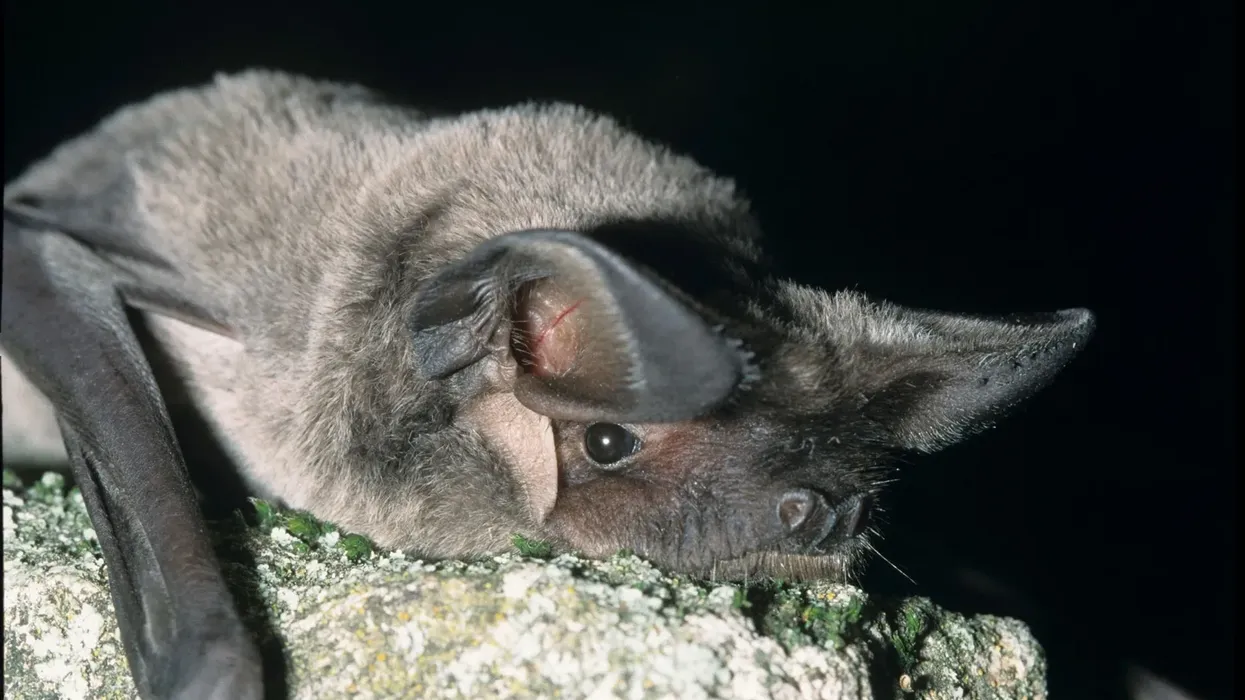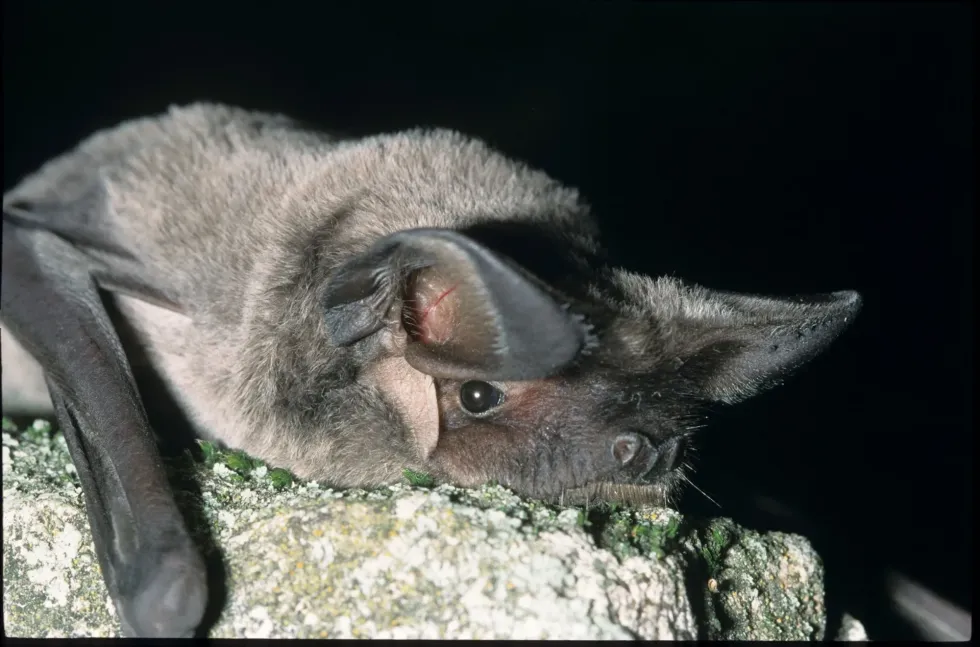Tadarida is a genus of free-tailed bats in the family Molossidae. There are a total of eight different species all endemic to geographic habitat ranges.
There is a prehistoric and extinct Tadarida species called Constantine's free-tailed bat. They are called 'free-tailed' because of the tail that extends beyond the uropatagium, a membrane near the legs.
They are medium-sized bats that are very powerful fliers. They tend to be social and live in a very large roost or in maternity colonies. Tadarida bats are largely insectivorous when it comes to food and feed on creatures like butterflies, grasshoppers, and dragonflies.
They also fall prey to animals like cats, hawks, owls, and falcons. Brazilian or Mexican free-tailed bats have the distinction of being one of the fastest flying animals in the world.
All but three Tadarida species of bats are considered Least Concern by the IUCN. The La Touche's free-tailed bat and East Asian free-tailed bat are Endangered and the African giant free-tailed bat is Data Deficient.
For more relatable content, check out these bateleur eagle facts and hoary bat facts for kids.
Tadarida Interesting Facts
What type of animal is a Tadarida?
A Tadarida is a free-tailed bat.
What class of animal does a Tadarida belong to?
Tadarida bats belong to the Mammalia class of animals.
How many Tadaridas are there in the world?
The exact number of Tadarida free-tailed bats left in the world is uncertain since there are eight different bat species native to different geographic habitat ranges. Bat populations are difficult to quantify.
Where does a Tadarida live?
Tadarida bats are found in a number of different parts of the world. Seven of the eight free-tailed bats are native to the Old World including North Africa, Europe, southern Asia, and Japan to India.
Four of the species are found only in the African range, including the island of Madagascar. Populations of two species occur in southern and western Australia and in central parts of Papua New Guinea.
Brazilian free-tailed bats belong to the subgenus Rhizomops and are a New World species. They are found from Argentina and Chile in South America to the West Indies, Puerto Rico, and the United States in North America. Arizona's Eagle Creek Cave used to have a colony of 25-50 million bats during the '60s.
What is a Tadarida's habitat?
Tadarida bats tend to live in different kinds of habitats according to their geographic habitat range.
Egyptian free-tailed bats favor warm, arid, and semi-arid places in their range. They tend to avoid mountains and forests.
They like cliff faces, caves, and rock crevices for their diurnal colony roost. Egyptian free-tailed bats also nest in structures made by humans such as the roofs of churches and houses. Caves and dead trees are also favored to roost in.
The European free-tailed bat species likes tropical areas best, with some temperate ones. Elevations of 1,312-1,640 ft (400-500 m) are preferred. Colder climates are avoided since survival would become difficult. Destruction of dams is beneficial to European free-tailed bats, providing them with foraging and drinking areas. They like to forage in woodlands, scrublands, urban areas, and above lakes.
Mexican or Brazilian free-tailed bats occupy different types of roosting and breeding season sites such as bridges, attics, hollow trees, and primarily caves.
Who does the Tadarida live with?
Tadarida bats may live alone or in colonies. European free-tailed bats tend to live in big breeding colonies and are territorial. The Brazilian or Mexican free-tailed bat family is also social and lives in large colonies. All Tadarida bats are known for roosting in large caves.
How long does a Tadarida live?
The various Tadarida mammalian species collectively live for 7-13 years.
How do they reproduce?
Tadarida bats reproduce by mating and giving birth to live pups.
What is their conservation status?
As per the Red List of the International Union for Conservation of Nature, the conservation statuses of the various Tadarida species are different.
The La Touche's free-tailed bat and East Asian free-tailed bat are Endangered, while the African giant free-tailed bat is Data Deficient. The Kenyan big-eared free-tailed bat, European free-tailed bat, Egyptian free-tailed bat, Mexican or Brazilian free-tailed bat, and the Malagasy free-tailed bat are all species of Least Concern.
Tadarida Fun Facts
What does the Tadarida look like?
Tadarida bats are characterized by plain gray and brown fur and big ears. The Egyptian free-tailed bat (Tadarida aegyptiaca) bat displays sexual dimorphism, with female bats being slightly larger than males. The snout is upturned and long around the lip.
The ears are big and point forwards. The tragus of the ear is square and has an extra appendage.
The Egyptian free-tailed bat has a dorsal coat that is grayish-brown. There are some dark areas behind the head as well as on the back. Only Egyptian and Brazilian free-tailed bats have ears that are separated in the head's top.
European free-tailed bats also have broad, rounded, and long ears that touch in the front. They possess gray and black pelage but some bats have a brown tint. The fur or hair is short much like the pelage of a mole. The reported tail length is 1.6-2 in (4-5.2 cm).
The tails also have long hairs that are used for touching. The muzzle is long and the upper lip has five creases. The wings are narrow and long.
Mexican or Brazilian free-tailed bats also have short, distinctive snouts, and upper lips that are wrinkled. They have large ears, brown fur, and are medium-sized.
Their legs are powerful and the wings are narrow, pointed, and long which enables them to have a direct and rapid flight. The ears are 0.3-0.6 in (0.8-1.5 cm) long, the forearms are 1.5-1.6 in (3.7-4.1 cm) long, and the hind feet are 0.2-0.3 in (0.6-0.9 cm) long

How cute are they?
Tadarida bats are quite cute animals. They are small and fidgety and rather plain-colored. These macabre creatures have dainty, big ears, and are tremendously fast in flight.
How do they communicate?
Tadarida bats depend on echolocation to navigate their surroundings and locate prey. They also use visual, tactile, and barely audible cues. Egyptian free-tailed bats have a functioning olfactory system.
How big is a Tadarida?
Tadarida bats are 3.1-5.5 in (7.9-13.9 cm) long and have a wingspan of 11-17.7 in (28-45 cm), making them three to five times smaller than Indian flying foxes.
How fast can a Tadarida fly?
Tadarida bats are known for their quick, high-altitude, and direct flight. They are some of the fastest fliers in the world.
In fact, the Brazilian or Mexican free-tailed bat is one of the fastest flying animal in the world, achieving reported speeds of up to 100 mph (161 kph). Only peregrine falcons can go faster but only when they are falling or gliding downwards.
How much does a Tadarida weigh?
Tadarida bats family collectively weighs 0.2-1.1 oz (7-30 g).
What are the male and female names of the species?
Male and female Tadarida bats do not have specific names.
What would you call a baby Tadarida?
A baby Tadarida bat is called a pup.
What do they eat?
The different species of Tadarida bats are largely insectivorous and these bats eat insects, butterflies, moths, beetles, crickets, grasshoppers, locusts, dragonflies, antlion, green lacewings, termites, damselflies, spiders, sawflies, wasps, bees, and ants.
They get preyed on by a host of different predators such as domestic cats, lanner falcons, red-tailed hawks, American kestrels, great horned owls, barn owls, Mississippi kites, Virginia opossums, striped skunks, raccoons, eastern coachwhips, eastern coral snakes, other snakes, and other owls.
Are they dangerous?
Tadarida bats are not directly harmful. Since they roost in human-adjacent areas, there are often guano deposits that may contain harmful bacteria as well as pests and arthropods.
These deposits are however too small and dry. If someone were to come in contact, there is a risk of rabies, virus, and fungus transmission. There are few and unproven reports of human infection through viruses.
Would they make a good pet?
No, these wild creatures would most definitely not make good pets because they could cause human infection.
Did you know...
The amount of food Mexican free-tailed bats eats depends on the weather conditions, availability of prey, lunar illumination, and metabolic demands. The amount of food eaten by these North American bats is hard to pin down.
Mexican free-tailed bat groups have a home range of 154.4 sq. mi (400 sq. km).
Brazilian or Mexican free-tailed bats search for and consume mosquitoes and many other insects. These mammals live in the North American and South American continents and are also very common in Central America.
Mexican free-tailed bats of Central America live for 12 years on average.
Big-free-tailed bats mostly eat big moths but also eat stinkbugs, flying ants, and crickets in their diets. They belong to the genus Nyctinomops.
Tadarida free-tailed bats do not exhibit varying physical animal diversity among its many species.
What species come under Tadaridas?
Apart from the eight known Tadarida bats species, there used to be a prehistoric bat species called Constantine's free-tailed bat (Tadarida constantinei). Its status is Extinct.
Can Tadaridas kill you?
No, Tadaridas cannot directly kill you. They may transmit viruses and rabies if a human were to come in contact.
Here at Kidadl, we have carefully created lots of interesting family-friendly animal facts for everyone to discover! Learn more about some other mammals from our megabat fun facts and ghost bat fun facts for kids pages.
You can even occupy yourself at home by coloring in one of our free printable dawn bat coloring pages.
Second image by U.S. Fish and Wildlife Service Headquarters









